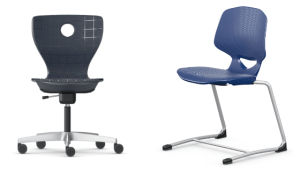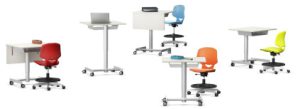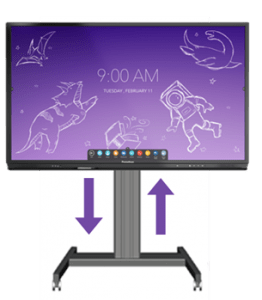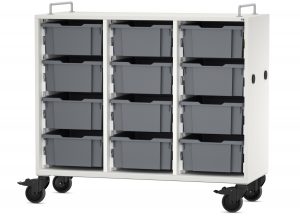Flexible Learning Spaces
The terms, flexible seating, flexible furniture, and flexible classroom are really the end product of the pedagogical change from teacher-centered learning to student-centered learning. A learner-centered environment embodies practices that optimize the students’ movement from whole-group instruction to smaller groupings, to personalized spaces.
A flexible learning space is designed to morph classroom activities into different learning configurations by using furniture, materials, tools and technology. It becomes an essential part of learning and teaching by enhancing both the students’ and teacher’s sensory input, physical movement, and psychological well-being.
I like to use the term, mobile and modular (or mobimod for short) to describe the live action of a classroom moving from one activity to the next. Imagine a fourth grade classroom working on a paper airplane building project in small groups, and then, the students easily move their “mobimod” furniture to the walls to make room for a square dancing activity happening five minutes later, in the same space.
To optimize such a flexible design, these face-to-face learning spaces utilize five categories of furniture and technology to enhance student movement, which in turn helps to spark their motivation, engagement, and creativity.
- Seating and Movement
Sitting with subtle movement while working independently or in groups
- Modular Sitting Tables
Sitting at shaped tables that optimize space while working in groups or independently
- Sit to Stand Tables and Movement
Having a standing option to weight-transfer while working independently or in groups
- AV & Visual Communications
Walls that talk using audio, video and visuals with a variety of fixed and mobile displays, and boards
- Mobile Storage
Bin and cabinet places organized and optimized for stacking and mobility. Personalized storage for each student, and for the variety of room materials, books, tools and technology
From Classroom to Learning Studio
As a child in the 20th century, you probably attended K-12 classrooms where all the desks and chairs were the same, probably in rows, facing the front chalkboard. As 21st century learning and teaching practices support literacy, STEAM, project-based learning, critical thinking, and collaborative learning, the curriculum has been transformed. What hasn’t evolved as much is the physically furnished classroom in this century. Stationary single or double desks and 4-legged chairs still make up most classrooms today designed for single activity whole-group instruction.
Change is often a slow process especially when considering the budget realities in changing out whole classrooms of furniture. However, in the last ten years many more teachers and administrators have moved together to sync their 21st century curriculum with a sprinkling of flexible furniture and technology in their classrooms. I call this process, “transitions to transformation” as the physical classroom evolves into what many are now calling, “Learning Studios.” As we move forward in the 2020’s, I see classrooms becoming learning studios as pedagogy and physical space converge to enhance student creativity, expression, and understanding.
Flexible Learning Space Assets
- Emulates the world of work – In the real world, adults work in teams. Project-based tasks are what most women and men do everyday at their jobs. In the 21st century, office space has transformed how people work in face-to-face environments that also facilitates online activities as well. Educators are empowered as designers to create learning spaces that now includes a broader mix of hard and soft furniture not only made for schools. This new mix includes furniture from office and work, hotel and restaurant, and home and living space environments.
- Designers of their space – A teacher working with her/his students should be the designers of their learning space. With a variety of district standard flexible furniture, the classroom design is often the first class project of the school year.
- A Social and Emotional Safe Nest – When students walk into a classroom, they need a safe place to land. Cozy is cool- both a physical and emotional feeling. Many students need the comfort of a welcoming classroom to serve as a springboard for the deep-dive of learning with a class of peers.
- Living with Covid – As collaborative teams had become standard practice in pre-covid classrooms, the pandemic has created learning challenges that include the furniture. Flexible shape desks and tables that can both be configured for group work, or can easily be reconfigured for social distancing space and individualized seating.
To flex minds, we need to flex classroom space. Learning spaces in the 2020’s need non-traditional eclectic designs to create a positive learning environment. The key to a flexible learning space combines a student’s need to fidget, rock, swivel, stretch, stand, and even get horizontal with mobile and modular furniture and technology. Subtle self-movement and weight transfer keeps our brains stimulated and helps prevent mental fatigue within a contained space. It’s really simple, physical movement sparks the mind to enhance one’s motivation, engagement, and creativity that opens paths for learning.
Resources
- Flexible Classroom by VS – https://www.youtube.com/watch?v=IU2C0hy7FV8
- Fostering Student Well-Being in Elementary Learning Spaces –
https://www.youtube.com/watch?v=8PulZZvr7tI - Well-Being by VS –
https://vsamerica.com/media/partnerNet/El/Elem/Elementary-Well-Being_Brochures2022.pdf - Design Patterns for Creative Learning Environments –
https://fieldingintl.com/design-patterns/ - D&D Project Portfolio –
https://ddlearningspaces.com/project/project-portfolio/ - D&D Products –
https://ddlearningspaces.com/products - This article has also been published in the Fall 2022 Issue of Slate Magazine – the quarterly magazine of the Idaho School Board Association:
https://www.idsba.org/blog/publications/slate-magazine/


0 Comments